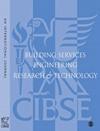使用建模和校准管理建筑从设计到运营的能源性能
IF 1.8
4区 工程技术
Q3 CONSTRUCTION & BUILDING TECHNOLOGY
Building Services Engineering Research & Technology
Pub Date : 2021-04-19
DOI:10.1177/01436244211008317
引用次数: 2
摘要
为了解决有关建筑能源性能差距的问题,有必要对建筑进行结构化和纵向的性能评估,包括从设计到运营。建模可以成为该过程的一个组成部分,方法是确保良好实践设计阶段建模之后,使用稳健的校准协议对操作阶段性能进行持续评估。在本文中,我们通过一个办公楼的案例研究,展示了如何使用一个新的框架来微调良好实践设计阶段模型,以适应运营阶段,该框架有助于验证实际性能与设计意图偏差的原因。本文绘制了从设计到运营的跟踪建筑性能的基于建模的过程,确定了各种类型的性能差距。此外,在运营阶段,该框架提供了一种系统的方法来区分(i)与设计假设相比,由建筑的实际功能和占用率驱动的运营条件的影响,以及(ii)导致表现不佳的潜在技术问题的影响。由于问题的识别是基于能源建模,因此该过程需要使用先进且有充分记录的模拟工具。论文最后概述了生成稳健设计模型所需的软件平台需求,以及运行性能评估所需的校准。实际应用该论文的研究结果为建筑行业专业人员提供了有用的指导,使他们能够在易于使用的工作流程中通过稳健的方法以适当的准确性管理绩效差距。分析使用中的建筑能源性能的方法框架将最佳实践设计阶段建模指导与稳健的运营阶段调查联系起来。它帮助设计师、承包商、建筑经理和其他利益相关者了解进行有效测量和验证所需遵循的程序。本文章由计算机程序翻译,如有差异,请以英文原文为准。
Managing energy performance in buildings from design to operation using modelling and calibration
To manage the concerns regarding the energy performance gap in buildings, a structured and longitudinal performance assessment of buildings, covering design through to operation, is necessary. Modelling can form an integral part of this process by ensuring that a good practice design stage modelling is followed by an ongoing evaluation of operational stage performance using a robust calibration protocol. In this paper, we demonstrate, via a case study of an office building, how a good practice design stage model can be fine-tuned for operational stage using a new framework that helps validate the causes for deviations of actual performance from design intents. This paper maps the modelling based process of tracking building performance from design to operation, identifying the various types of performance gaps. Further, during the operational stage, the framework provides a systematic way to separate the effect of (i) operating conditions that are driven by the building’s actual function and occupancy as compared with the design assumptions, and (ii) the effect of potential technical issues that cause underperformance. As the identification of issues is based on energy modelling, the process requires use of advanced and well-documented simulation tools. The paper concludes with providing an outline of the software platform requirements needed to generate robust design models and their calibration for operational performance assessments. Practical application The paper’s findings are a useful guide for building industry professionals to manage the performance gap with appropriate accuracy through a robust methodology in an easy to use workflow. The methodological framework to analyse building energy performance in-use links best practice design stage modelling guidance with a robust operational stage investigation. It helps designers, contractors, building managers and other stakeholders with an understanding of procedures to follow to undertake an effective measurement and verification exercise.
求助全文
通过发布文献求助,成功后即可免费获取论文全文。
去求助
来源期刊

Building Services Engineering Research & Technology
工程技术-结构与建筑技术
CiteScore
4.30
自引率
5.90%
发文量
38
审稿时长
>12 weeks
期刊介绍:
Building Services Engineering Research & Technology is one of the foremost, international peer reviewed journals that publishes the highest quality original research relevant to today’s Built Environment. Published in conjunction with CIBSE, this impressive journal reports on the latest research providing you with an invaluable guide to recent developments in the field.
 求助内容:
求助内容: 应助结果提醒方式:
应助结果提醒方式:


